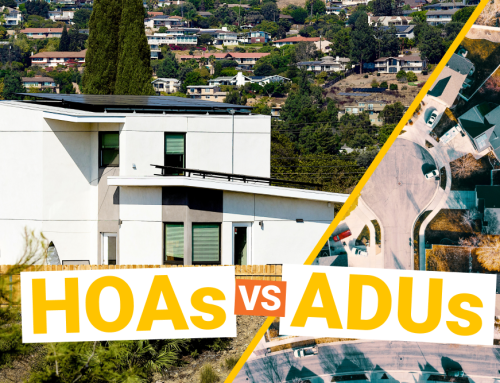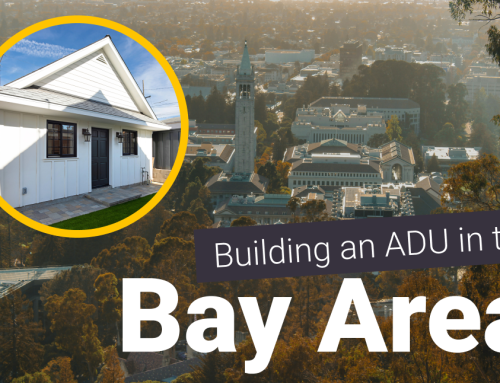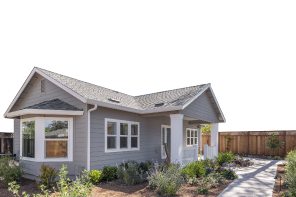As housing demands evolve and affordability becomes an increasing concern, ADUs have emerged as a viable solution to address the housing shortage while offering homeowners opportunities for additional income and flexible living arrangements.
Orange County, nestled between bustling Los Angeles and San Diego, finds itself at the crossroads of urban expansion and suburban charm. As waves of residents seek refuge from the soaring costs of living in neighboring cities, Orange County faces the challenge of accommodating this influx while preserving its distinct character and quality of life.
ADUs offer a compelling solution, allowing homeowners to maximize the use of their property while contributing to the region’s housing supply. However, navigating the regulatory maze governing ADU development can be daunting. We’re here to simplify the process.
What is required in an ADU in Orange County?
Before diving into the regulations, it’s important to first define what an accessory dwelling unit is required to have. In Orange County, an ADU is required to have:
- A kitchen
- A bathroom
- A separate entrance
- Bedroom or sleeping area
- Utilities
An ADU is defined as a permanent residential unit, separate from the primary residence, that contains all facilities required for independent living. Essentially, everything that is required in a regular-sized single family home will be required in your ADU. Let’s get into the specifics.

Kitchen
A kitchen in an ADU is required to have countertops, appliances, sink, storage cabinets, and electrical outlets.
Bathroom
The ADU must have at least one bathroom that includes a sink, toilet, and bath tub or shower.
Exterior Access
The ADU cannot share an entrance with the primary residence, meaning that the tenant of the unit should not have to enter the main house to access the ADU.
Note: this regulation differs from junior accessory dwelling units (JADUs)
Bedroom or Sleeping Area
While there are no strict size requirements for bedrooms in ADUs, it’s important to ensure that the space is adequately sized to accommodate a bed, storage furniture, and other necessary furnishings. If a bedroom is not feasible, your ADU can also be a studio. However, there must still be adequate space for a bed.
Utilities
ADUs must have all utilities required for independent living including water, sewage, and electricity.
Orange County ADU Regulations

For the most part, the Orange County follows California state ADU regulations, which are already fairly lenient to begin with.
Allowed ADUs in Orange County
Following state regulations, almost any homeowner in California is entitled to at least one 800 sq ft ADU on their property, regardless of floor area ratio, front setbacks, or property size.
This ADU can be any of the following:
Detached ADU: The ADU is a stand-alone unit and does not share a wall with any part of the primary residence or any other accessory structure on the property.
Attached ADU: The ADU is attached or located within the primary home.
Conversion ADU: The ADU is converted from an accessory structure already on the property such as a garage or other spaces within the primary home like a basement or attic.
Above Garage ADU: The ADU is built above the garage and includes its own stairway to access the unit.
Single-family properties are allowed up to one conversion ADU, one detached ADU, and one JADU if there is adequate space.
Junior Accessory Dwelling Units (JADUs)

There is another allowed ADU type that deserves its own section.
Junior Accessory Dwelling Units (JADUs) are essentially what they sound like. They are intended to be smaller than a regular ADU and converted from an existing space within the primary residence. However, size is not the only difference. Here are the key takeaways when it comes to JADU regulations:
- Max size: 500 sq ft.
- It can only be converted from pre-existing space within the primary residence, like a master bedroom
- Owner occupancy is required
- A bathroom is not required, BUT if you do not add a bathroom, the JADU must have interior access to the primary home’s bathroom.
- A full kitchen is not required in a JADU, but it must meet “efficiency kitchen” requirements
- Parking must be replaced if you are converting the garage into a JADU
Cost-wise, JADUs will cost about the same as a basic garage conversion ADU. With that in mind, an ADU may be a better option for most because of their flexibility.
ADU Sizes
Back to regular ADUs!
The max sizes allowed for your ADU will depend on the type, however, remember that you are always allowed to build at least an 800 sq ft ADU.
Detached ADUs: Cannot exceed 1,200 sq ft
Attached ADUs: Up to 50% of the primary residence’s living area, unless this figure is less than 800 sq ft. For example, if 50% of your main residence’s living area is only about 700 sq ft, you are still allowed to build an 800 sq ft ADU.
Conversion ADUs: Depending on the size of the structure being converted, there is no max size. For example, if you have a barn on your property that is 1,400 sq ft, the city must allow you to convert the entire structure into an ADU. You are also allowed an additional 150 sq ft, but ONLY to allow for ingress and egress.
ADU Heights

Just like with sizes, the max heights allowed in Orange County will depend on the type of ADU you intend to build, but you are always allowed at least 16 ft.
Detached ADUs: A detached ADU can only be up to 16 ft, except for the following circumstances:
- Up to 18 ft is allowed if the property is located within half a mile walking distance from a public transit stop
- An additional 2 ft is allowed (up to 20 ft) to accommodate the roof pitch if it is needed to match the pitch of the primary dwelling
Attached ADUs: An attached ADU can be up to 25 ft or comply with the height restrictions applicable to the zone in which the property is located. Whichever is lower.
Conversions ADUs: Heights for conversions will depend on whether the structure is attached or detached. See above.
ADU Setbacks
Setbacks for side and rear may be a minimum of four feet. Front setbacks will depend on your zone’s underlying building standards, however, if these setbacks interfere with your ability to build an 800 sq ft ADU, they cannot be enforced.
If you are building a detached ADU, the unit must have a six foot distance from the primary residence and any other structures on the property.
Parking Requirements
Off-street parking is required for ADUs (one per unit or bedroom) except in the following circumstances:
- The ADU is located within half a mile walking distance from public transit
- The ADU is located within an architecturally or historically significant district
- The ADU is converted from an existing space or accessory structure
- On-street parking permits are required but not offered to the occupant of the ADU
- A car share vehicle is located within one block of the ADU
- Your ADU is a studio
For garage conversions ADUs, you do not need to replace the parking space that was lost as a result of the conversion. In the event you need/want to add off-street parking for your ADU, the new parking space can be placed within the setbacks.
With your newfound ADU knowledge in mind, you’re ready to start building your team of ADU professionals to get the job done.
Get Connected to Orange County ADU Professionals With Maxable
Maxable has matched hundreds of homeowners all throughout California to designers, lenders, and builders. We meticulously vet every person that comes through our network to ensure our clients are getting matched with quality professionals for all of their ADU needs.
Orange County especially benefits from Maxable’s extensive network of ADU professionals. Whether you’re navigating the complex regulations of Orange County or seeking expert guidance on design, financing, or construction, Maxable connects you with trusted professionals who understand the unique nuances of ADU development in the region.
Schedule a call with our team today to tell us about your ADU dreams, and we’ll get started curating your custom ADU team.








